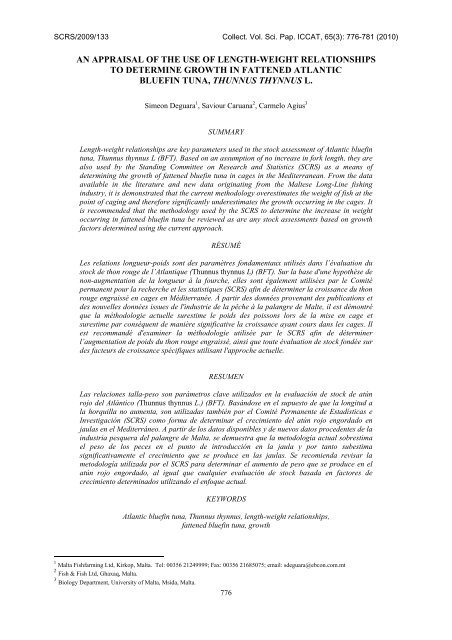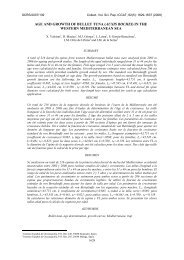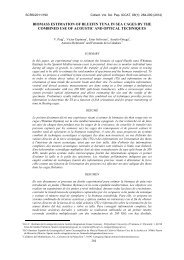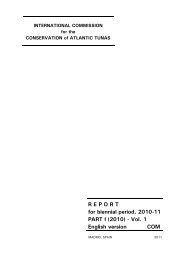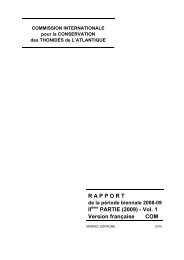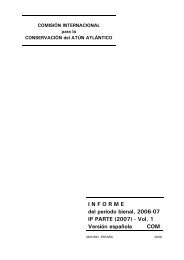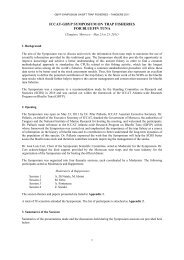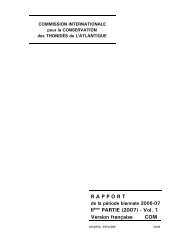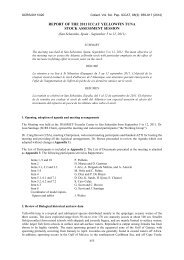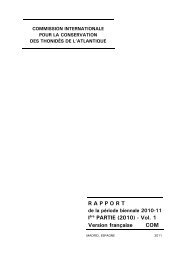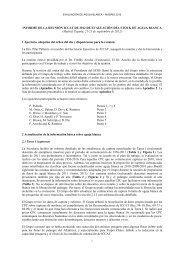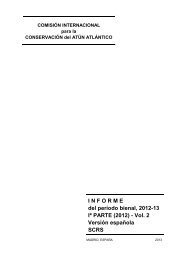SCRS/2009/133 - Iccat
SCRS/2009/133 - Iccat
SCRS/2009/133 - Iccat
Create successful ePaper yourself
Turn your PDF publications into a flip-book with our unique Google optimized e-Paper software.
<strong>SCRS</strong>/<strong>2009</strong>/<strong>133</strong> Collect. Vol. Sci. Pap. ICCAT, 65(3): 776-781 (2010)AN APPRAISAL OF THE USE OF LENGTH-WEIGHT RELATIONSHIPSTO DETERMINE GROWTH IN FATTENED ATLANTICBLUEFIN TUNA, THUNNUS THYNNUS L.Simeon Deguara 1 , Saviour Caruana 2 , Carmelo Agius 3SUMMARYLength-weight relationships are key parameters used in the stock assessment of Atlantic bluefintuna, Thunnus thynnus L (BFT). Based on an assumption of no increase in fork length, they arealso used by the Standing Committee on Research and Statistics (<strong>SCRS</strong>) as a means ofdetermining the growth of fattened bluefin tuna in cages in the Mediterranean. From the dataavailable in the literature and new data originating from the Maltese Long-Line fishingindustry, it is demonstrated that the current methodology overestimates the weight of fish at thepoint of caging and therefore significantly underestimates the growth occurring in the cages. Itis recommended that the methodology used by the <strong>SCRS</strong> to determine the increase in weightoccurring in fattened bluefin tuna be reviewed as are any stock assessments based on growthfactors determined using the current approach.RÉSUMÉLes relations longueur-poids sont des paramètres fondamentaux utilisés dans l’évaluation dustock de thon rouge de l’Atlantique (Thunnus thynnus L) (BFT). Sur la base d'une hypothèse denon-augmentation de la longueur à la fourche, elles sont également utilisées par le Comitépermanent pour la recherche et les statistiques (<strong>SCRS</strong>) afin de déterminer la croissance du thonrouge engraissé en cages en Méditerranée. À partir des données provenant des publications etdes nouvelles données issues de l'industrie de la pêche à la palangre de Malte, il est démontréque la méthodologie actuelle surestime le poids des poissons lors de la mise en cage etsurestime par conséquent de manière significative la croissance ayant cours dans les cages. Ilest recommandé d'examiner la méthodologie utilisée par le <strong>SCRS</strong> afin de déterminerl’augmentation de poids du thon rouge engraissé, ainsi que toute évaluation de stock fondée surdes facteurs de croissance spécifiques utilisant l'approche actuelle.RESUMENLas relaciones talla-peso son parámetros clave utilizados en la evaluación de stock de atúnrojo del Atlántico (Thunnus thynnus L.) (BFT). Basándose en el supuesto de que la longitud ala horquilla no aumenta, son utilizadas también por el Comité Permanente de Estadísticas eInvestigación (<strong>SCRS</strong>) como forma de determinar el crecimiento del atún rojo engordado enjaulas en el Mediterráneo. A partir de los datos disponibles y de nuevos datos procedentes de laindustria pesquera del palangre de Malta, se demuestra que la metodología actual sobrestimael peso de los peces en el punto de introducción en la jaula y por tanto subestimasignificativamente el crecimiento que se produce en las jaulas. Se recomienda revisar lametodología utilizada por el <strong>SCRS</strong> para determinar el aumento de peso que se produce en elatún rojo engordado, al igual que cualquier evaluación de stock basada en factores decrecimiento determinados utilizando el enfoque actual.KEYWORDSAtlantic bluefin tuna, Thunnus thynnus, length-weight relationships,fattened bluefin tuna, growth1 Malta Fishfarming Ltd, Kirkop, Malta. Tel: 00356 21249999; Fax: 00356 21685075; email: sdeguara@ebcon.com.mt2 Fish & Fish Ltd, Ghaxaq, Malta.3 Biology Department, University of Malta, Msida, Malta.776
calculate the RWT of BFT entering the farm from the FLs, the following equation from Arena (Unpublished)was used:RWT = (1.9607x10 -5 ) x (FL) 3.0092With this approach used on 66 harvested farmed BFT data sets, the <strong>SCRS</strong> found that only approximately half ofthe harvested populations showed a positive growth. Using the selected results, the <strong>SCRS</strong> calculated a growthvalue of around 14% (ICCAT, <strong>2009</strong>).The growth in the farm will affect the physical condition of the fish and this has been shown in work carried outwith farmed fish. This was seen by Aguado-Gimenez & Garcia-Garcia (2005a, b) and by the present authors.Figure 2 presents the L-W relationship for harvested BFT from fattening farms in Malta in 2007 (data collectedby Government of Malta Observers) (FL converted from curved fork length using a factor of 0.955 (Parrack, etal., 1979). The L-W relationship obtained from the farm data wasRWT = (2.3139x10 -5 ) x (FL) 2.9840 (n = 3961, FL = 86-293cm).The calculated RWTs for harvested fattened BFT of 150, 200, 250 and 300cm are 72, 170, 331 and 570kgrespectively which are only slightly higher than the weights obtained using the Arena (Unpublished) equation.The equation obtained by the authors also resembles closely the equations obtained by Aguado-Gimenez &Garcia-Garcia (2005a, b) with fattened BFT.From the information available, it is clear that the Arena (Unpublished) equation does not apply to the BFT atthe time when they are caught and put into farm cages for fattening purposes. Therefore, the weight at input isoverestimated greatly with the result that when the <strong>SCRS</strong> apply their growth calculation, a significantly lowergrowth, or even a negative growth, is obtained. Additionally, this approach by the <strong>SCRS</strong> assumes that there is noincrease in length, an assumption which as yet remains unproven. In fact, the research carried out by Aguado-Gimenez & Garcia-Garcia (2005) and Gimenez-Casalduero & Sanchez-Jerez (2006) has shown a clear increasein length in BFT held in farms.As shown in Table 2, even assuming no increase in FL, fish entering the farm with a low condition factor willhave increased in weight significantly by the time of harvest. Furthermore, allowing for an increase in FL of 20,12, 5 and 2% of FL for fish starting at 150, 200, 250 and 300cm respectively over a fattening period of 6 months,an increase which is not unreasonable according to the data available, even more significant increases in RWTcan be expected (Table 3). The figures presented in Tables 2 and 3 are based on the equations obtained from theMaltese LL fishing data; using figures obtained by some of the other authors cited in Table 1 would havepredicted even bigger percentage increases in RWT.It is clear that the current methodology for determining growth in fattened BFT based on the assumption of noincrease in FL and on the use of the Arena (Unpublished) equation are inadequate to provide a meaningfulestimate of growth for fattened BFT. In addition, stock assessments which have been based on growth factorscalculated using this approach should be reviewed.AcknowledgmentsThis work was funded by the Federation of Maltese Aquaculture Producers as part of their ongoing researchprogramme on bluefin tuna biology.ReferencesAguado-Gimenez, F. and Garcia-Garcia, B. 2005ª, Growth, food intake and feed conversion rates in captiveAtlantic bluefin tuna (Thunnus thynnus Linnaeus, 1758) under fattening conditions. Aquacult. Res., 36: 610-614.Aguado-Gimenez, F. and Garcia-Garcia, B. 2005b, Changes in some morphometric relationships in Atlanticbluefin tuna (Thunnus thynnus thynnus Linnaeus, 1758) as a result of fattening process. Aquaculture, 249:303-309.Arena, P. (Unpublished).778
Butler, M.J.A. 1974, Prince Edward Island bluefin tuna research program 1974. Prince Edward Island MarineFisheries and Training Centre and Department of Tourism, Ports and Conservation, P.E.I.: 1-65.Cunningham, E.M., Restrepo, V.R. and de la Serna, J.M. 2002, Updated estimates of conversion factors forbluefin tuna from product weight to live weight. Collect. Vol. Sci. Pap. ICCAT, 54(2): 527-530.Fushimi, H., Kami, K., Nakamara, S. and Srour, A. 1995, Preliminary report on size composition of giant bluefintuna caught in the Gibraltar Strait by Moroccan handline fishery. Collect. Vol. Sci. Pap. ICCAT, 44(2): 382-387.Fushimi, H., Srour, A., Kani, K. and Nhhala, H. 1998, Monthly changes in size composition and the lengthweightrelationship of giant bluefin tuna caught in the Strait of Gibraltar. Collect. Vol. Sci. Pap. ICCAT,50(2): 490.Gimenez-Casalduero, F. and Sanchez-Jerez, P. 2006, Fattening rate of bluefin tuna Thunnus thynnus in twoMediterranean fish farms. Cybium, 30: 51-56.Hattour, A. 2003, Relation taille poids des captures de thon rouge (Thunnus thynnus) en Tunisie. Collect. Vol.Sci. Pap. ICCAT, 55(1): 217-223.ICCAT <strong>2009</strong>, Report of the 2008 Atlantic Bluefin Tuna Stock Assessment Session (Madrid, Spain, June 23 toJuly 4, 2008. Collect. Vol. Sci. Pap. ICCAT, 64(1): 1-352.Kebir, El., N.K., Rodriquez-Cabello, C. and Tawil, M.Y.O. 2002, Age estimation of bluefin tuna (Thunnusthynnus, L.) caught by traps in Libyan waters based on spine reading. Collect. Vol. Sci. Pap. ICCAT, 54(2):641-648.Mather, F.J. III, Mason, J.M. Jr. and Jones, A.C. 1995, Historical Document: Life History and Fisheries ofAtlantic Bluefin Tuna. NOAA Technical Memorandum, NMFS-SEFSC, 370, 165pp.Parrack, M. and Phares, P. 1979, Aspects of the growth of Atlantic bluefin tuna determined from mark-recapturedata. Collect. Vol. Sci. Pap. ICCAT, 8(2): 356-366.Parrack, M.L., Brunenmeister, S.L. and Nichols, S. 1979, An analysis of Atlantic bluefin tuna catches, 1960-1976. Collect. Vol. Sci. Pap. ICCAT, 8 (2): 391-420.Rey, J.C. and Cort, J. L. (Unpublished).Rivas, L.R. 1955, A comparison between giant bluefin tuna (Thunnus thynnus) from the Straits of Florida andthe Gulf of Maine, with reference to migration and population identity. In: Proceedings of the Gulf andCaribbean Fisheries Institute, Seventh Annual Session, Havana, Cuba, November 1954: <strong>133</strong>-149.Rodriguez-Roda, J. 1964, Talla, peso y edad de los atunes, Thunnus thynnus (L.), capturados por la almadraba deBarbate (costa sudatlantica de Espana) en 1963 y comparacion con el periodo 1956 a 1962. Investig. Pesq.,26: 3-47.Santos dos, M.N., Garcia, A., Lino, P.G. and Hirofumi, M. 2004, Length-weight relationships and weightconversion factors for bluefin tuna (Thunnus thynnus thynnus) from the Algarve: prior to and after fattening.Collect. Vol. Sci. Pap. ICCAT, 56(3): 1089-1095.Tawil El, M., Kabir El, N., Urbina de, O., Valeiras, J. and Abad, E. 2004, Length-weight relationships forbluefin tuna (Thunnus thynnus L.) caught from the Libyan trap fishery in 1999-2002. Collect. Vol. Sci. Pap.ICCAT, 56(3): 1192-1195.Ticina, V., Grubisic, L., Katavic, I., Franicevic, V., Ticina, V.E. and Ozic, M. 2006, Conversion of farmedbluefin tuna product weight to live weight of fish. Collect. Vol. Sci. Pap. ICCAT, 58(4): 1271-1284.Ticina, V., Katavic, I. and Grubisic, L. 2007, Growth indices of small northern bluefin tuna (Thunnus thynnus,L.) in growth-out rearing cages. Aquaculture, 269: 538-543.779
Table 1. Round weight (RWT) of bluefin tuna of 150, 200, 250 and 300cm fork length (FL) calculated from thelength-weight relationships determined by various authors.FL (cm) 150 200 250 300AuthorCalculated RWT (kg)Arena (Unpublished) 69 165 322 558El Kebir et al. (2001), Trap, Libya, Male 53 121 229 386El Kebir et al. (2001), Trap, Libya, Female 61 131 239 389Hantour (2003), Purse Seine, Tunisia 56 132 257 441dos Santos et al. (2004), Trap, Entering Med 53 130 263 466dos Santos et al. (2004), Trap, Leaving Med 51 115 215 358Tawil et al. (2004), Trap, Libya 55 124 233 390Aguado-Gimenez & Garcia-Garcia (2005), Purse Seine, Balearic 60 132 243 398Table 2. Calculated percentage increase in round weight (RWT) of harvested fattened bluefin tuna assuming noincrease in fork length (FL) during fattening period. RWT calculated using relevant length-weight relationships(Maltese longline 2008, Maltese farms 2007).FL at start of fattening (cm) 150 200 250 300RWT of BFT caught 16-30 June 2008 60 137 262 444RWT of harvested fattened BFT assuming same FL 72 170 331 570% Increase in RWT assuming same FL 20 24 26 28Table 3. Calculated percentage increase in round weight (RWT) of harvested fattened bluefin tuna allowing foran increase in fork length (FL) during the fattening period. RWT calculated using relevant length-weightrelationships (Maltese longline 2008, Maltese farms 2007).FL at start of fattening (cm) 150 200 250 300RWT of BFT caught 16-30 June 2008 60 137 262 444% Increase in FL after fattening 20 12 5 2New RWT of harvested fattened BFT allowing for an increase in FL 124 239 383 605% Increase in RWT after allowing for an increase in FL 107 74 46 36780
600500533499479444RWT (kg)400300200158154 15013730929428426210067 67 66600150 200 250 300FL (cm)01-15 May 16-31 May 01-15 Jun 16-30 JunFigure 1. Change in round weight (RWT) of bluefin tuna, Thunnus thynnus, caught by Maltese Long-Linefishing in May and June 2008. Calculated RWTs indicated (kg) for each fork length (FL)(cm).600500400RWT (kg)30020010000 50 100 150 200 250 300 350FL (cm)Figure 2. Length-weight relationship of harvested bluefin tuna, Thunnus thynnus, from fattening farms in Malta(RWT = Round weight; FL = Fork length).`781


